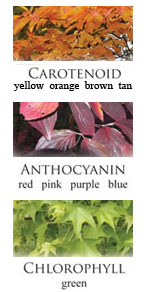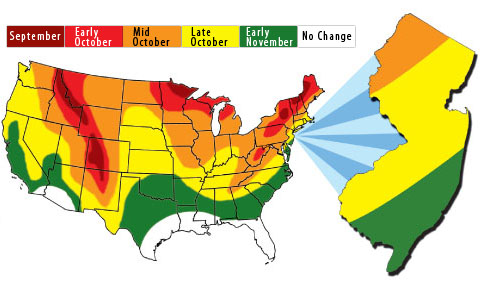Fall Foliage
Cool crisp autumn days usher in the breathtaking colors of New Jersey's fall foliage. From September through November, New Jersey's state parks and forests provide endless opportunities to experience the brilliant transformation of the leaves.
Fall Color Progression
This graph shows the three waves of fall color - yellow, orange, and red. Depending on the region, each wave takes seven to 16 days to progress. In mid-season, where the three colors intersect, the fall display ismost colorful.

Fall Conditions for Best Color
- Number of leaves — Many leaves (no early leaf drop)
- Health of tree — No Leaf damage or pests
- Sunlight — More sun and less cloud cover
- Rain — Intermitant light rain - no heavy rain or drought
- Temperature — Cool at night without frost
Autumn changes begin in the mountainous regions and progress southward toward lower regions. With expansive deciduous forests, Eastern North America has one of the best fall color displays in the world.

During the growing months, leaves produce chlorophyll, a green-colored pigment. Through chlorophyll the tree uses the sunlight’s energy to combine carbon dioxide and water to make glucose, which serves as food for the tree. This process is called photosynthesis.
As summer ends, shorter days and colder air alerts the tree that winter is coming. The tree severs the leaves’ connection to water and minerals from the roots. The leaves begin to die and chlorophyll production ends. The sunlight breaks down chlorophyll which reveals carotenoid pigments previously masked by the deep green.
The remaining chlorophyll produces lots of sugar, which is not used up by the tree. Red pigments called anthocyanins are created through excess sugar and more sunlight. Sunny days and cool nights provide the best weather for good anthocyanin production. You may notice that the leaves may be more red where the tree receives direct sunlight. Shaded leaves don’t produce as many anthocyanins and appear less brilliant.
More information on fall color
US Forest Service Fall Color Hotline 1-800-354-4595
US Forest Service Online www.fs.fed.us/fallcolors/
NJ Travel & Tourism Online www.nj.gov/travel/feature_fall_foliage.html
Fall Foliage Network - Fall Foliage Report



